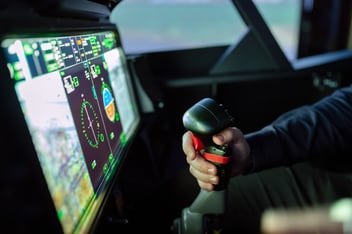Gesture Control and SWIR
With modern technology continuously advancing, especially in the sensor industry, improvements made to gesture control are stalled. Due to current SWIR (short-wave infrared) sensors’ high price, integration into consumer electronics is difficult without increasing the end product’s cost. Current gesture control units implement IR (infrared) sensors into their systems but see lower performance levels. These issues stem from infrared’s lack of visibility in low-light conditions, lower object detectability, scattering, and limited range. Products that have now begun to integrate gesture control systems include TVs (Figure 1), gaming systems, lights, vehicles, and air conditioners but countless other technologies stand to benefit from the implementation of SWIR gesture control.

Figure 1. “Gesture Ring” Hand-gesture-based TV replacing need for remote control. Image provided by TLC.
Image sensors that can view into the SWIR region are able to differentiate objects based on their absorption (or reflectance) of light captured by the sensor’s camera. This also works in low-light settings, whereas current IR sensors have difficulties recognizing gestures. An example of this is seen in paper towel dispensers that have difficulty recognizing hand movement, especially in different skin types. Light conditions also affect the sensor’s performance since infrared sensors depend on light emitting sources that are reflected by objects, limiting the observable distances of the infrared camera.
But if cameras used in gesture control systems begin to integrate SWIR into their systems it will provide a higher performance. SWIR is capable of effectively identifying objects in low light conditions and only requiring light emitted when long-rage visibility is required, making higher performance achievable. Benefitting the camera’s system to identify objects in low-light to no-light environments especially for differing skin types that have less reflectance and absorbance, SWIR has a proven higher success rate when analyzing skin types that have differing melanin content making the gestures more distinctive to the camera. Lower performance caused by scattering in adverse conditions such as fog, haze, and dust, means longer wavelengths are “lost” when projected and reflected, reducing the amount of wavelengths that can be absorbed by the image sensor providing a lower-quality image. But SWIR sensors are not as prone to scattering, granting the ability to produce a clearer image to the system to correctly identify hand movement and direction it is moving in.
The benefits of improved gesture control systems will help many communities, especially ones who have health conditions that affect their mobility. For example, people who are affected by Parkinson’s are unable to correctly grip controls rendering them unable to use remotes or gaming controllers. Systems that can integrate SeeDevice’s patented quantum photodetector technology can help make products more accessible from improvements made to performance and detectability. With decreased scattering and the ability to distinguish skin types in low-light conditions, we can predict more advanced and accurate gesture control systems that would ease life for all soon.



